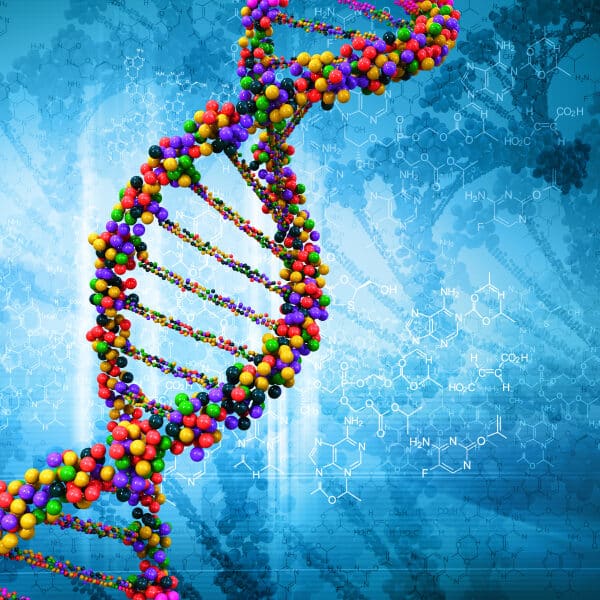
We don’t yet fully understand what causes Alzheimer’s disease, but other types of dementia are more understood and we know for instance that changing lifestyle factors like not smoking, drinking and eating fishy and oily foods while partaking of exercise decreases the risk of dementia’s that have a vascular or other functional aspect. However, the more we learn about Alzheimers disease in particular, the more we learn that genes play an important role in its development.
What are genes?
Genes are units inside a cell that control how living organisms inherit features from their ancestors; for example, children usually look like their parents because they have inherited their parents’ genes. Genetics is a branch of science which tries to identify which features are inherited, and explain how these features pass from one generation to the next.
Genes are made from a long molecule called DNA, which is copied and inherited across generations. DNA is made of single units that line up in a particular order within this long molecule. The order of these units carries genetic information, similar to how the order of letters on a page carries information. The information within a particular gene is not always exactly the same between one organism and another, so different copies of a gene do not always give exactly the same instructions in human beings – as two parents genetic codes are required to fertilise an egg which produces us – it is the interaction of these two sets of DNA which can sometimes produce mutations.
These mutations are important for survival and progress of any species as they allow adaptation, sometimes however the particular ‘blend’ can lead to diseases – some of these diseases are then passed on to future generations.
The Genetics of Disease
Some diseases are caused by a genetic mutation, or permanent change in one or more specific genes. If a person inherits from a parent a genetic mutation that causes a certain disease, then he or she will usually get the disease. Sickle cell anaemia, cystic fibrosis, and early-onset familial Alzheimer’s disease are examples of inherited genetic disorders.
In other diseases, a genetic variant may occur. This change in a gene can sometimes cause a disease directly. More often, it acts to increase or decrease a person’s risk of developing a disease or condition.
When a genetic variant increases disease risk but does not directly cause a disease, it is called a genetic risk factor.
Genetics of Alzheimer’s disease
Alzheimer’s disease is an irreversible, progressive brain disease, which as of yet, we cannot prevent nor cure.
It is characterized by the development of amyloid plaques and neurofibrillary tangles, the loss of connections between nerve cells, or neurons, in the brain, and the subsequent death of these nerve cells. There are two types of Alzheimer’s commonly defined—early onset and late-onset. Both types have a genetic component. However we are also learning that most late onset dementia’s are probably of a mixed pathology – simply put a person has developed the characteristic markers of DAT but also shows signs of damage to the brain structures from vascular origin and or incident.
Early-onset Alzheimer’s disease occurs in people age 30 to 60. It is rare, representing less than 5 percent of all people who have Alzheimer’s.
Some cases of early-onset Alzheimer’s have no known cause, but most cases are inherited, a type known as familial Alzheimer’s disease (FAD).
Familial Alzheimer’s disease is caused by any one of a number of different single-gene mutation on chromosomes 21, 14, and 1. Each of these mutations causes abnormal proteins to be formed. A child whose mother or father carries a genetic mutation for FAD has a 50/50 chance of inheriting that mutation. If the mutation is inherited, the child almost surely will develop FAD.
Most cases of Alzheimer’s are the late-onset form, which develops after age 60 and the prominence of which then increases in the population significantly for every further 5 years. By age 85 as many as 1 in 3 people will develop an Alzheimer or other form of dementia .
The causes of late-onset Alzheimer’s are not yet completely understood, but they likely include a combination of genetic, environmental, and lifestyle factors that influence a person’s risk for developing the disease.
The single-gene mutations directly responsible for early-onset Alzheimer’s disease do not seem to be involved in late-onset Alzheimer’s. Researchers, as yet, have not found a specific gene that causes the late-onset form of the disease. However, one genetic risk factor does appear to increase a person’s risk of developing the disease.
Apolipoprotein E
This increased risk is related to the apolipoprotein E (APOE) gene found on chromosome 19. APOE contains the instructions for making a protein that helps carry cholesterol and other types of fat in the bloodstream.
There are three forms—APOE e2, APOE e3, and APOE e4—which occur most frequently. APOE e2 is relatively rare and may provide some protection against the disease. If Alzheimer’s disease occurs in a person with this allele, (an allele is one variant of one gene) it develops later in life than it would in someone with the APOE e4 gene.
APOE e3, the most common allele, but is believed to play a neutral role in the disease—neither decreasing nor increasing risk. APOE e4 is present in about 25 to 30 percent of the population and in about 40 percent of all people with late-onset Alzheimer’s. People who develop Alzheimer’s are more likely to have an APOE e4 allele than people who do not develop the disease.
The good news!
APOE e4 is called a risk-factor gene because it increases a person’s risk of developing the disease. Inheriting an APOE e4 allele does not mean that a person will definitely develop Alzheimer’s disease. Some people with one or two APOE e4 alleles never get the disease, and others who develop Alzheimer’s do not have any APOE e4 alleles.
So we can answer our troubled relatives now from an informed (though slightly technical) vantage point. We know inheriting DAT is very rare – only about 5% – and the family will be aware of this fact through their medical practitioner who will have screened them since birth and we know there are lifestyle choices we can make throughout our lives that may protect us from developing late onset DAT and other forms of dementia even if we are genetically prone to the disease.
Having a Mother or father, Brother or Sister who develops a late onset dementia does not mean we definitely will go on to realise a dementia in our old age but we should take it as a lesson and start to look after our health as we do now know that changing our diets, taking more exercise and laying off the things that could kill us anyways such as smoking and heavy drinking decreases our risk factors considerably.
Till next time
Paul Smith – Dementia Care Expert




